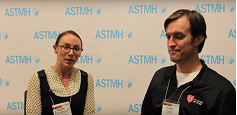Stanford CIGH is on the scene at the American Society of Tropical Medicine and Hygiene (ASTMH) 65th Annual Meeting taking place this week in Atlanta, Ga. The five-day conference is the premier forum for the exchange of scientific advances in tropical medicine and draws approximately 4,400 attendees representing academia, government, non-profits, philanthropy, NGOs, industry, military and private practice dedicated to reducing the burden of tropical infectious diseases and improving health for all. More than 20 Stanford students, researchers and faculty are attending this year's meeting, representing over 30 abstracts.

A year after the Ebola epidemic in West Africa, a study led by researchers at Stanford University and Partners in Health identified 14 individuals previously unknown to have had the disease in a Sierra Leone village that was an Ebola hotspot during the outbreak. Results from this study were published Nov. 15 in
PLOS Neglected Tropical Diseases and presented the day prior during a packed symposium on Ebola transmission, vaccines, clinical sequelae and minimally symptomatic infection at the American Society of Tropical Medicine and Hygiene (ASTMH) Annual Meeting. The session was co-chaired by the publication’s lead author Gene Richardson, MD, of Stanford University and senior author Paul Farmer, MD, PhD, of Harvard University and Partners in Health.
In combining the initial reports of 34 previously reported cases with the 14 newly identified cases, the researchers calculated the prevalence of minimally symptomatic infection in the village to have been 25 percent.
I had a chance to speak with many of the researchers involved in the study at ASTMH to discuss the significance of the findings and potential implications for the estimated scale of the outbreak, survivors of Ebola and need for further study of minimally symptomatic Ebola infection.
“Right now, we have no way of telling which people are going to be minimally symptomatic and which are not, so these numbers are relevant. If there are potentially 50,000 to 60,000 episodes of transmission, it means we did a really bad job of containment,” explained Gene Richardson, MD, former infectious disease fellow at the Stanford School of Medicine who is now a PhD candidate in anthropology at the university. “What this means for survivors is that it potentially changes the definition…if we expand what it means to be a survivor to those who are IGG positive, it means there are potentially a lot more people in the pool.”
Watch the video to hear more from Richardson and Farmer, as well as co-authors Mohamed Bailor Barrie, MD, a physician with Partners in Health and Wellbody Alliance in Sierra Leone, Daniel Kelly, MD, infectious disease fellow at the University of California, San Francisco, and Michele Barry, MD, FACP, director of Stanford’s
Center for Innovation in Global Health, which provided seed funding for the study. Also contributing to the research was James Holland Jones, PhD, associate professor of Earth systems science and senior fellow at the
Stanford Woods Institute for the Environment who presented separate research at ASTMH.
Read the
Stanford Medicine press release
Read more from
The Wall Street Journal, Los Angeles Times and
NPR.